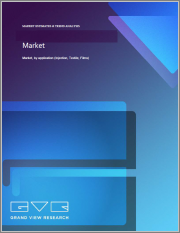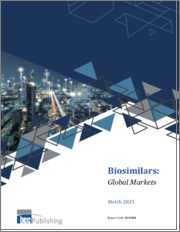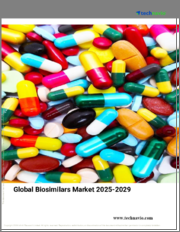
|
시장보고서
상품코드
1321333
세계의 바이오시밀러 시장 규모, 점유율, 동향 분석 : 제품별, 용도별, 지역별, 부문별 예측(2023-2030년)Biosimilars Market Size, Share & Trends Analysis By Product (Recombinant Glycosylated Proteins, Recombinant Non-Glycosylated Proteins), By Application (Rheumatoid Arthritis, Oncology), By Region And Segment Forecasts 2023 - 2030 |
||||||
바이오시밀러 시장 성장과 동향
Grand View Research, Inc. 최신 보고서에 따르면 세계의 바이오시밀러(Biosimilars) 시장 규모는 2023년부터 2030년까지 15.9%의 CAGR을 기록했으며, 2030년 762억 달러 규모에 달할 것으로 예측됩니다.
시장은 환자, 제조업체 양쪽 비용대비 효과가 높고, 암이나 빈혈 등의 만성, 비감염성 질환 유병률이 증가하고 있는 것에 기인하고 있습니다. 세계보건기구(WHO) 추계에 따르면 5세 미만 아이의 40%, 15-49세 여성의 30%가 빈혈에 시달리고 있습니다. 또한, 바이오시밀러 의약품은 거의 유사한 결과를 가져오고, 기준 생물학적 제형보다 저렴한 대안으로 여겨집니다.
거의 유사하기 때문에 생물학적 제제 생산자는 바이오시밀러에 대항하기 위해 가격을 낮추어야 하며 전체 치료비가 절감됩니다. 예를 들어 바이오시밀러 포럼이 2021년 4월에 발표한 보고서에 따르면 바이오시밀러와 경쟁이 심화됨에 따라 생물학적 제형 가격은 평균 56%에서 최대 150%의 CAGR로 성장하여 인하되었습니다. 또한 생물 제제는 바이오시밀러와 경쟁을 방지하기 위한 특허가 있습니다. 이 특허는 각국 규제에 따라 8-20년 기간 중 바이오시밀러 생산을 제한합니다. 그러나 많은 구명 생물 제제 특허는 예측 기간 중 만료될 것으로 예상되며, 이는 성장을 지원할 수 있습니다.
2021년 4월 발표된 미국 의회 예산국 기사에 따르면 미국 식품약국(FDA)은 2020년 29개 바이오시밀러 의약품을 승인했으며, 그 중 일부는 여전히 시장에 도입되지 않습니다. 또한 제네릭 의약품, 바이오시밀러, 구상(Generics and Biosimilars Initiative) 기사에 따르면 암젠사의 바이오시밀러 "솔리스" 시장 도입은 2025년으로 연기되었습니다. COVID-19 팬데믹 발생은 시장에 악영향을 미쳤습니다. 의약품을 포함한 다양한 제품 공급망이 끊어졌으며 대부분 공급업체가 COVID-19 대책에 전념했기 때문에 바이오시밀러 생산은 원재료 부족에 빠졌습니다.
예를 들어 존스 홉킨스 대학의 블룸버그 공중 보건 대학원이 발표한 보고서에 따르면 봉쇄 결과, 의약품 제조에 사용되는 중요 원재료인 원약(API) 공급 부족이 관찰되었습니다. 이러한 공급 부족은 유행 중에 바이오시밀러 및 기타 의약품 생산과 공급에 직접적인 영향을 미쳤습니다. 그러나 수요가 증가함에 따라 다수 시장 기업이 바이오시밀러 연구개발에 많은 투자를 하고 있으며, 이는 시장 성장을 더욱 견인할 수 있습니다. 예를 들어 고급 생명공학 솔루션을 제공하는 주요 플레이어인 Amgen Inc.는 10개 바이오시밀러 의약품 개발에 20억 달러를 투자하고 있습니다.
바이오시밀러 시장 보고서 하이라이트
- 제품별로는 유전자 재조합 비글리코실화 단백질 분야가 2022년 54.9% 최대 매출 점유율을 차지했습니다.
- 한편, 유전자 재조합 당쇄 단백질 분절은 복수 구명용 생물 제제 특허가 곧 만료될 것으로 예상되기 때문에 예측 기간 중 14.9%의 CAGR로 가장 빠른 성장이 예상됩니다.
- 만성 및 자가면역 질환 용도는 이러한 질병 유병률이 증가함에 따라 2022년 가장 큰 판매 점유율을 차지했습니다.
- 암 영역은 암 이환율 증가와 중요 생물 제제 특허가 가깝기 때문에 예측 기간 중 17.0%의 CAGR 성장을 기록할 전망입니다.
- 2022년 여러 주요 기업이 존재하는 북미가 40.4% 점유율을 차지하고 시장을 독점했습니다. 한편, 아시아태평양은 신제품 상시와 헬스케어 지출 증가로 예측 기간 중 18.4%의 CAGR로 가장 급성장하는 지역으로 예측됩니다.
목차
제1장 조사 방법과 범위
- 시장 세분화 및 범위
- 조사 방법
- 정보 조달
- 정보 또는 데이터 분석
- 시장 형성과 검증
- 모형 상세
- 2차 정보 리스트
- 1차 정보 리스트
- 목적
제2장 주요 요약
제3장 바이오시밀러 시장 변수, 동향, 범위
- 시장 계통 전망
- 모 시장 전망
- 관련/부수 시장 전망
- 보급과 성장 전망 매핑
- 업계 밸류체인 분석
- 상환 틀
- 시장 역학
- 시장 촉진 요인 분석
- 시장 억제 요인 분석
- 바이오시밀러 시장 분석 툴
- 포터의 업계 분석
- PESTEL 분석
제4장 바이오시밀러 시장 : 제품 추정, 동향 분석
- 바이오시밀러 시장 : 중요 포인트
- 바이오시밀러 시장 : 동향과 시장 점유율 분석(2022-2030년)
- 재조합 비글리코실화 단백질
- 재조합 비글리코실화 단백질 시장 추계, 예측(2018-2030년)
- 인간 성장호르몬
- 과립구 콜로니 자극 인자
- 인터페론
- 인슐린
- 재조합 글리코실화 단백질
- 재조합 글리코실화 단백질 시장 추계, 예측(2018-2030년)
- 에리스로포이에틴
- 모노클로널 항체
- 폴리트로핀
제5장 바이오시밀러 시장 : 용도, 추정, 동향 분석
- 바이오시밀러 시장 : 중요 포인트
- 바이오시밀러 시장 : 동향과 시장 점유율 분석(2022-2030년)
- 종양학
- 혈액 질환
- 성장호르몬 결핍증
- 만성 및자가면역질환
- 기타
제6장 바이오시밀러 시장 :지역 추정, 동향 분석
- 지역별 전망
- 지역별 바이오시밀러 시장 : 주요마켓플레이스 요점
- 북미
- 시장 추계, 예측(2018-2030년)
- 미국
- 캐나다
- 유럽
- 영국
- 독일
- 프랑스
- 이탈리아
- 스페인
- 스웨덴
- 노르웨이
- 덴마크
- 아시아태평양
- 일본
- 중국
- 인도
- 호주
- 태국
- 한국
- 라틴아메리카
- 브라질
- 멕시코
- 아르헨티나
- 중동 및 아프리카
- 사우디아라비아
- 남아프리카
- 아랍에미리트(UAE)
- 쿠웨이트
제7장 경쟁 상황
- 주요 시장 진입 기업 최근 동향과 영향 분석
- 시장 진입 기업 분류
- Amgen Inc.
- F Hoffman La Roche Ltd.
- Sandoz International GmbH
- Dr. Reddy"s Laboratories Ltd.
- Teva Pharmaceutical Industries Ltd.
- Pfizer Inc.
- Samsung Biopis
- Biocon
- Viatris Inc.
- Celltrion Healthcare Co., Ltd
- AbbVie Inc.
Biosimilars Market Growth & Trends
The global biosimilars market size is expected to reach USD 76.2 billion by 2030, registering a CAGR of 15.9% from 2023 to 2030, according to a new report by Grand View Research, Inc. The growth of this market can be attributed to their cost effectiveness for both patients & manufacturers and the increasing prevalence of chronic & non-communicable diseases, such as cancer and anemia. According to the World Health Organizationestimates, 40% of children below five years of age, and 30% of women between the age group of 15 and 49 years are suffering from anemia. Moreover, biosimilar drugs offer almost similar results and are considered a more affordable alternative to their reference biologics.
Since they are almost similar, the producers of biologics also have to lower their prices to compete with biosimilars, which reduce the cost of the overall treatment. For instance, a report published by Biosimilars Forum in April 2021 suggests that increasing competition from biosimilars has resulted in lowering the prices of biologics by an average of 56% to up to 150%. Furthermore, biologics have patents to protect them from competing with biosimilars. These patents restrict the production of biosimilars for a period of 8 to 20 years depending on the regulations in different countries. However, patents of many lifesaving biologics are expected to expire during the forecast period, which can boost growth.
According to an article by Congressional Budget Office published in April 2021, the U.S. Food and Drugs Administration (FDA) had approved 29 biosimilar drugs by 2020, and some of them were yet to be introduced in the market. Furthermore, an article by Generics and Biosimilars Initiative suggests, the entry of Amgen's biosimilar Soliris was delayed till 2025. The outbreak of the COVID-19 pandemic had a negative impact on the global market. Since the supply chains of different products including pharmaceuticals were disrupted and most of the sources were dedicated to fighting COVID-19, the production of biosimilars experienced a shortage of raw materials.
For instance, according to a report published by Johns Hopkins Bloomberg School of Public Health, as a result of the lockdown, a shortage was observed in the supply of Active Pharmaceutical Ingredient (API), which is an important raw material used in producing drugs. These shortages directly affected the production and supply of biosimilars and other drugs during the pandemic. However, due to the increasing demand, several market players are significantly investing in the research & development of biosimilars, which can further add to the market growth. For instance, a key player offering advanced biotechnology solutions, Amgen Inc., has invested USD 2 billion in the development of 10 biosimilar medicines.
Biosimilars Market Report Highlights
- Based on product, the recombinant non-glycosylated proteins segment accounted for the largest revenue share of 54.9% in 2022 due to a rise in the regulatory approvals for biosimilars from different governments
- On the other hand, the recombinant glycosylated proteins segment is expected to grow at the fastest CAGR of 14.9% during the forecast period as the patents of several lifesaving biologics are expected to expire soon
- The chronic and autoimmune disorders application segment accounted for the largest revenue share in 2022owing to the rising prevalence of these diseases
- The oncology segment is expected to register the fastest CAGR of 17.0% during the forecast period due to the increasing prevalence of cancer and upcoming patent expiration for important biologics
- In 2022, North America dominated the market with a share of 40.4% owing to the presence of several key players. On the other hand, Asia Pacific is anticipated to be the fastest-growing region at a CAGR of 18.4% over the forecast period due to new product launches and increasing healthcare expenditure
Table of Contents
Chapter 1. Methodology and Scope
- 1.1. Market Segmentation & Scope
- 1.1.1. Product
- 1.1.2. Application
- 1.1.3. Regional scope
- 1.1.4. Estimates and forecast timeline.
- 1.2. Research Methodology
- 1.3. Information Procurement
- 1.3.1. Purchased database
- 1.3.2. GVR's internal database
- 1.3.3. Secondary sources
- 1.3.4. Primary research
- 1.3.5. Details of primary research
- 1.4. Information or Data Analysis
- 1.4.1. Data analysis models
- 1.5. Market Formulation & Validation
- 1.6. Model Details
- 1.7. List of Secondary Sources
- 1.8. List of Primary Sources
- 1.9. Objectives
- 1.9.1. Objective 1
- 1.9.2. Objective 2
Chapter 2. Executive Summary
- 2.1. Market Outlook
- 2.2. Segment Outlook
- 2.2.1. Product outlook
- 2.2.2. Application outlook
- 2.2.3. Regional outlook
- 2.3. Competitive Insights
Chapter 3. Biosimilars Market Variables, Trends & Scope
- 3.1. Market Lineage Outlook
- 3.1.1. Parent market outlook
- 3.1.2. Related/ancillary market outlook.
- 3.2. Penetration & Growth Prospect Mapping
- 3.3. Industry Value Chain Analysis
- 3.3.1. Reimbursement framework
- 3.4. Market Dynamics
- 3.4.1. Market driver analysis
- 3.4.1.1. Increasing emphasis on cutting down healthcare expenditure
- 3.4.1.2. Cost-effectiveness of biosimilar drugs
- 3.4.1.3. Positive outcome in the ongoing clinical trials
- 3.4.1.4. R&D investments are increasing.
- 3.4.1.5. Patent expiration of biologics to boost the biosimilars market
- 3.4.2. Market restraint analysis
- 3.4.2.1. High manufacturing complexities and costs
- 3.4.2.2. Presence of non-original biologics and biobetters
- 3.4.1. Market driver analysis
- 3.5. Biosimilars Market Analysis Tools
- 3.5.1. Industry Analysis - Porter's
- 3.5.1.1. Supplier power
- 3.5.1.2. Buyer power
- 3.5.1.3. Substitution threat
- 3.5.1.4. Threat of new entrant
- 3.5.1.5. Competitive rivalry
- 3.5.2. PESTEL Analysis
- 3.5.2.1. Political landscape
- 3.5.2.2. Technological landscape
- 3.5.2.3. Economic landscape
- 3.5.1. Industry Analysis - Porter's
Chapter 4. Biosimilars Market: Product Estimates & Trend Analysis
- 4.1. Biosimilars Market: Key Takeaways
- 4.2. Biosimilars Market: Movement & Market Share Analysis, 2022 & 2030
- 4.3. Recombinant Non-glycosylated Proteins
- 4.3.1. Recombinant non-glycosylated proteins market estimates and forecasts, 2018 to 2030 (USD Billion)
- 4.3.2. Human growth hormone
- 4.3.2.1. Human growth hormone market estimates and forecasts, 2018 to 2030 (USD Billion)
- 4.3.3. Granulocyte colony-stimulating factor
- 4.3.3.1. Granulocyte colony-stimulating factor market estimates and forecasts, 2018 to 2030 (USD Billion)
- 4.3.4. Interferons
- 4.3.4.1. Interferons market estimates and forecasts, 2018 to 2030 (USD Billion)
- 4.3.5. Insulin
- 4.3.5.1. Insulin market estimates and forecasts, 2018 to 2030 (USD Billion)
- 4.4. Recombinant Glycosylated Proteins
- 4.4.1. Recombinant glycosylated proteins market estimates and forecasts, 2018 to 2030 (USD Billion)
- 4.4.2. Erythropoietin
- 4.4.2.1. Erythropoietin market estimates and forecasts, 2018 to 2030 (USD Billion)
- 4.4.3. Monoclonal antibodies
- 4.4.3.1. Monoclonal antibodies market estimates and forecasts, 2018 to 2030 (USD Billion)
- 4.4.4. Follitropin
- 4.4.4.1. Follitropin market estimates and forecasts, 2018 to 2030 (USD Billion)
Chapter 5. Biosimilars Market: Application Estimates & Trend Analysis
- 5.1. Biosimilars Market: Key Takeaways
- 5.2. Biosimilars Market: Movement & Market Share Analysis, 2022 & 2030
- 5.3. Oncology
- 5.3.1. Oncology market estimates and forecasts, 2018 to 2030 (USD Billion)
- 5.4. Blood Disorders
- 5.4.1. Blood disorders market estimates and forecasts, 2018 to 2030 (USD Billion)
- 5.5. Growth Hormonal Deficiency
- 5.5.1. Growth hormonal deficiency market estimates and forecasts, 2018 to 2030 (USD Billion)
- 5.6. Chronic And Autoimmune Disorders
- 5.6.1. Chronic and autoimmune disorders market estimates and forecasts, 2018 to 2030 (USD Billion)
- 5.7. Others
- 5.7.1. Others market estimates and forecasts, 2018 to 2030 (USD Billion)
Chapter 6. Biosimilars Market: Regional Estimates & Trend Analysis
- 6.1. Regional Outlook
- 6.2. Biosimilars Market by Region: Key Marketplace Takeaway
- 6.3. North America
- 6.3.1. Market estimates and forecasts, 2018 - 2030 (Revenue, USD Billion)
- 6.3.2. U.S.
- 6.3.2.1. Market estimates and forecasts, 2018 - 2030 (Revenue, USD Billion)
- 6.3.3. Canada
- 6.3.3.1. Market estimates and forecasts, 2018 - 2030 (Revenue, USD Billion)
- 6.4. Europe
- 6.4.1. UK
- 6.4.1.1. Market estimates and forecasts, 2018 - 2030 (Revenue, USD Billion)
- 6.4.2. Germany
- 6.4.2.1. Market estimates and forecasts, 2018 - 2030 (Revenue, USD Billion)
- 6.4.3. France
- 6.4.3.1. Market estimates and forecasts, 2018 - 2030 (Revenue, USD Billion)
- 6.4.4. Italy
- 6.4.4.1. Market estimates and forecasts, 2018 - 2030 (Revenue, USD Billion)
- 6.4.5. Spain
- 6.4.5.1. Market estimates and forecasts, 2018 - 2030 (Revenue, USD Billion)
- 6.4.6. Sweden
- 6.4.6.1. Market estimates and forecasts, 2018 - 2030 (Revenue, USD Billion)
- 6.4.7. Norway
- 6.4.7.1. Market estimates and forecasts, 2018 - 2030 (Revenue, USD Billion)
- 6.4.8. Denmark
- 6.4.8.1. Market estimates and forecasts, 2018 - 2030 (Revenue, USD Billion)
- 6.4.1. UK
- 6.5. Asia Pacific
- 6.5.1. Japan
- 6.5.1.1. Market estimates and forecasts, 2018 - 2030 (Revenue, USD Billion)
- 6.5.2. China
- 6.5.2.1. Market estimates and forecasts, 2018 - 2030 (Revenue, USD Billion)
- 6.5.3. India
- 6.5.3.1. Market estimates and forecasts, 2018 - 2030 (Revenue, USD Billion)
- 6.5.4. Australia
- 6.5.4.1. Market estimates and forecasts, 2018 - 2030 (Revenue, USD Billion)
- 6.5.5. Thailand
- 6.5.5.1. Market estimates and forecasts, 2018 - 2030 (Revenue, USD Billion)
- 6.5.6. South Korea
- 6.5.6.1. Market estimates and forecasts, 2018 - 2030 (Revenue, USD Billion)
- 6.5.1. Japan
- 6.6. Latin America
- 6.6.1. Brazil
- 6.6.1.1. Market estimates and forecasts, 2018 - 2030 (Revenue, USD Billion)
- 6.6.2. Mexico
- 6.6.2.1. Market estimates and forecasts, 2018 - 2030 (Revenue, USD Billion)
- 6.6.3. Argentina
- 6.6.3.1. Market estimates and forecasts, 2018 - 2030 (Revenue, USD Billion)
- 6.6.1. Brazil
- 6.7. MEA
- 6.7.1. Saudi Arabia
- 6.7.1.1. Market estimates and forecasts, 2018 - 2030 (Revenue, USD Billion)
- 6.7.2. South Africa
- 6.7.2.1. Market estimates and forecasts, 2018 - 2030 (Revenue, USD Billion)
- 6.7.3. UAE
- 6.7.3.1. Market estimates and forecasts, 2018 - 2030 (Revenue, USD Billion)
- 6.7.4. Kuwait
- 6.7.4.1. Market estimates and forecasts, 2018 - 2030 (Revenue, USD Billion)
- 6.7.1. Saudi Arabia
Chapter 7. Competitive Landscape
- 7.1. Recent Developments & Impact Analysis, By Key Market Participants
- 7.2. Market Participant Categorization
- 7.2.1. Amgen Inc.
- 7.2.1.1. Company overview
- 7.2.1.2. Financial performance
- 7.2.1.3. Product benchmarking
- 7.2.1.4. Strategic initiatives
- 7.2.2. F Hoffman La Roche Ltd.
- 7.2.2.1. Company overview
- 7.2.2.2. Financial performance
- 7.2.2.3. Product benchmarking
- 7.2.2.4. Strategic initiatives
- 7.2.3. Sandoz International GmbH
- 7.2.3.1. Company overview
- 7.2.3.2. Financial performance
- 7.2.3.3. Product benchmarking
- 7.2.3.4. Strategic initiatives
- 7.2.4. Dr. Reddy's Laboratories Ltd.
- 7.2.4.1. Company overview
- 7.2.4.2. Financial performance
- 7.2.4.3. Product benchmarking
- 7.2.4.4. Strategic initiatives
- 7.2.5. Teva Pharmaceutical Industries Ltd.
- 7.2.5.1. Company overview
- 7.2.5.2. Financial performance
- 7.2.5.3. Product benchmarking
- 7.2.5.4. Strategic initiatives
- 7.2.6. Pfizer Inc.
- 7.2.6.1. Company overview
- 7.2.6.2. Financial performance
- 7.2.6.3. Product benchmarking
- 7.2.6.4. Strategic initiatives
- 7.2.7. Samsung Biopis
- 7.2.7.1. Company overview
- 7.2.7.2. Financial performance
- 7.2.7.3. Product benchmarking
- 7.2.7.4. Strategic initiatives
- 7.2.8. Biocon
- 7.2.8.1. Company overview
- 7.2.8.2. Financial performance
- 7.2.8.3. Product benchmarking
- 7.2.8.4. Strategic initiatives
- 7.2.9. Viatris Inc.
- 7.2.9.1. Company overview
- 7.2.9.2. Financial performance
- 7.2.9.3. Product benchmarking
- 7.2.9.4. Strategic initiatives
- 7.2.10. Celltrion Healthcare Co., Ltd
- 7.2.10.1. Company overview
- 7.2.10.2. Financial performance
- 7.2.10.3. Product benchmarking
- 7.2.10.4. Strategic initiatives
- 7.2.11. AbbVie Inc.
- 7.2.11.1. Company overview
- 7.2.11.2. Financial performance
- 7.2.11.3. Product benchmarking
- 7.2.11.4. Strategic initiatives
- 7.2.1. Amgen Inc.
(주말 및 공휴일 제외)


















